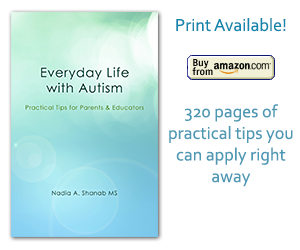By Nadia Shanab | Uncategorized
An amazing story of a seven-year-old autistic girl in a resaurant and her perception about a cheeseburger cut in two halves. Arianna called it the “broken cheeseburger” and couldn’t eat it. Why? She can only eat a “fixed cheeseburger”. My Expanation I guess Arianna had never seen a burger cut in half in her plate
Tags: asperger's syndrome, autism, communication, flexibility, health, visual aids, visual timer
Posted in Uncategorized | Comments Off on Arianna and The “Broken Cheeseburger”
By Nadia Shanab | Uncategorized
Dear Parents, This message is not aiming to burden you further with more efforts or worries. It is rather a call for co-operation with school to get the best out of the time your child spends in school. Here are some simple tips that can save you and the educators a huge amount of time
Tags: asperger's syndrome, autism, communication, consequences, discipline, flexibility, health, independence, organization, parenting, schedule, sensory, techniques, tips
Posted in Uncategorized | Comments Off on Tips to Maximize Learning Time
By Nadia Shanab | Uncategorized
To celebrate the “Autism International Day”, my book “Everyday Life with Autism” is now on sale for $14.99 only till April 13th. Autism International Day is April 2, 2013. Don’t forget to light up the blue light, and help raising awareness. nadia shanab
Tags: asperger's syndrome, autism, books, health, independence, parenting, research, sensory, social interaction, tips
Posted in Uncategorized | Comments Off on Save $10 (40% Off) On Book Purchase
By Nadia Shanab | Uncategorized
“A research published in JAMA Psychiatry states that older men who have children are more likely to have grandchildren with autism compared to men who have children at a younger age.” The risk factor of autism accumulates over generations. It might skip a generation. We always thought that the parents’ age may be a factor
Tags: autism, health, parenting, research
Posted in Uncategorized | Comments Off on Grandparents’ Age ls Linked to Autism Risk
By Nadia Shanab | Uncategorized
NAO is the name of the humanoid robot, an elaborate and very sophisticated system, created to help children with ASD. The main function of NAO is to improve the social skills and communication abilities of children with ASD. Kids with ASD usually have poor joint attention. Joint attention, is the ability to synchronize the attention
Tags: autism, communication, health, occupational therapy, parenting, research, senses, sensory, social interaction, speech, visual aids
Posted in Uncategorized | Comments Off on A Humanoid to Improve Social Skills in Kids with ASD
By Nadia Shanab | Uncategorized
Researchers believe that the increase of awareness might be behind the climb of this number. The ratio of boys to girls affected with autism is still the 4:1. The CDC (Centers for Disease Control and Prevention) and the U.S. Department of Health and Human Services believe that the increase might be due to the diagnosis
Tags: autism, communication, health, parenting, prevalence of autism, research, social interaction, speech, symptoms of autism
Posted in Uncategorized | Comments Off on Autism Prevalence Shot to One in 50 in The U.S.
By Nadia Shanab | Uncategorized
Neuroscientists in Georgetown University Medical Center (GUMC) discovered a brain odditiy in individuals with autism that explains the deficit in identifying faces . This deficit in turn explains the behavioral disorder in social interactions, which is one of the most common traits of autism. They suggest that the level of behavioral deficit may be linked to
Tags: autism, communication, health, parenting, research, social interaction
Posted in Uncategorized | Comments Off on Impairment in Social Interaction Is Linked to Deficit in Face Recognition
By Nadia Shanab | Uncategorized
A study titled: “Developmental Meta-Analysis of the Funcitonal Neural Correlates of Autism Spectrum Disorders,” found that the brain activity changes as individuals with autism age. They found that the change in brain activities keeps developing over time. This is the first study to show that. “If the shift in the parts of the brain that
Tags: aging, autism, brain activities, flexibility, health, parenting, research, techniques
Posted in Uncategorized | Comments Off on Brain Activities Change As Individuals with Autism Age
By Nadia Shanab | Uncategorized
“Signs of autism can be detected in the brains of 4-months old infants.” Researchers used near-infrared spectroscopy (NIRS) to study the brain activity of two groups of infants, one of which had a sibiling with autism. The babies were tested during a socially interesting human actions, (peek-a-boo), as well as while listening to some vocal
Tags: autism, early detection, health, research, signs, symptoms of autism
Posted in Uncategorized | Comments Off on Scanner ‘Shows Early Autism Signs’
By Nadia Shanab | Uncategorized
Speech and language Pathologists (SLP) found that half of the children have echolalia as part of their language development progress. The difference between NT (Neuro Typical) kids with and without echolalia (NOT including ASD kids) is that their self-generated language develops later, but eventually they still can catch up. Spectrum kids, on the other hand,
Tags: autism, communication, flexibility, health, parenting, speech, Temple Grandin, transition
Posted in Uncategorized | Comments Off on Echolalia Signals A Delay Not A disorder

